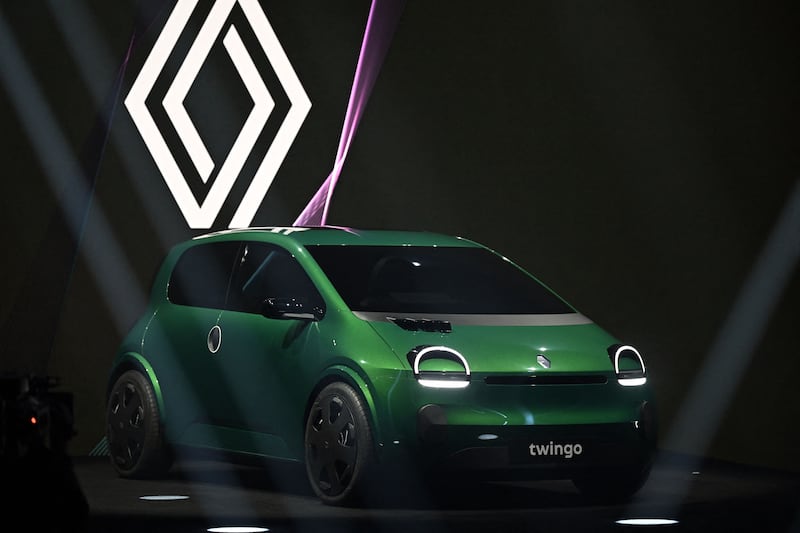Renault has been dipping deep into its back catalogue as it revs up its electric car line-up. To replace the Zoe, it’s making a new small electric hatch which looks very much like a restomodded original 1980s Renault 5. Alongside that will be a new electric crossover, which will mimic the styling of the original utilitarian Renault 4 – a car that in many ways was the original crossover.
Now though, at an investors’ event where Renault wanted to seriously hype up its electric car future, the French carmaker revealed a new Twingo electric hatchback which looks almost entirely like the quite brilliant Patrick Le Quement-designed 1991 original and which is slated to go on sale by 2025 with a price tag of less than €20,000 – before government subsidies. It also looks, just possibly, as if it might be a five-door model. The original Twingo was only ever a three-door car.
At the same time, Renault is not going to be making the Twingo. Or the 5 EV. Or the 4 EV. Well, it will but it won’t – in common with Ford and some other carmakers, Renault is “carving out” (the company’s words) a new firm, dedicated to developing electric cars and software.
Called Ampere, the company is kinda-sorta a start-up, but one owned by Renault Group. It will design and engineer cars to be sold under the Renault brand. “In the true spirit of Renault, Ampere is engineered to make electric and connected cars affordable for all, addressing the imperatives of energy transition and seizing the growth opportunities on the market,” said Luca De Meo, Renault’s chief executive, at the announcement of both the Twingo and the new company.
READ MORE
“Ampere combines the best of two worlds: the experience and firepower of a leading carmaker and the agility and innovation of a newcomer,” he added. “Ampere is ESG in 3D, designed from scratch reaching the highest standard in terms of decarbonisation, circular economy and fair transition. I’m more than confident that the success of Ampere relies on the expertise and enthusiasm of a highly diverse team that has proven extremely effective in the last two years of preparation.”
Even as he was bigging up the new Ampere set-up to investors as the company prepares for a stock-market float, De Meo was also claiming the new Twingo would be “a car from the guts of Renault”. By that he means it’s following firmly in the footsteps of classic models such as the 4, the 5, the 16, the Clio and the original Twingo in that it takes some radical ideas, and puts them into an affordable package.
Impressively, De Meo was also making some eyebrow-raising claims for the Twingo’s efficiency, saying it had been designed to achieve 10kWh/100km, at a time when some small EVs struggle to do twice that figure. If it can be done it could be the secret to the new Twingo EV’s tantalising price – that kind of efficiency would mean Renault could extract a usable range, perhaps 250km or even 300km, from a tiny battery, which is the best way of trimming the cost of any new electric model.
As headline-grabbing as that sub-€20,000 price is, De Meo went on to claim that for those buying on finance, the new Twingo would be even better, with monthly repayments on a PCP as low as €100. That figure, however, is likely to be specific to France, where the government is both pressing and incentivising carmakers to offer super-affordable EVs to budget-conscious buyers.
It’s also where Ampere comes in. According to De Meo, Ampere will be a key to unlocking electric vehicles that are directly comparable in price terms to conventional petrol or diesel models. “Thanks to its clear roadmap of 40 per cent cost reduction in one generation, Ampere will be able to gradually reduce vehicles’ prices while improving margins,” he said.
“Indeed, benefiting from the rolling start of Renault Group on EV and software, Ampere provides a low-risk and high-return financial profile with the ambition to reach break-even point in 2025 (both in operating margin and in free cash flow) and targets an operating margin above 10 per cent from 2030 onwards. Beyond its own line-up, Ampere is also designed to be a technological, manufacturing and business platform for other brands, which represents further upsides for Ampere.”

That 40 per cent reduction in the cost of building EVs will be achieved, says De Meo, between now and 2028, and includes battery designs that are 50 per cent cheaper, a 25 per cent reduction in the cost of making the entire electric architecture, a similar cut in the cost of making the platform that lies under each vehicle and a 15 per cent cut in the cost of making the individual vehicle bodies.
Officially, the new Twingo isn’t being called the Twingo yet. It’s still technically known as the ‘Legend’ concept, but its visual reference to the original Twingo is unmistakable. That first-generation Twingo was never made in right-hand drive, and never came to Ireland. Here’s hoping that Renault doesn’t leave us out in the cold again.











